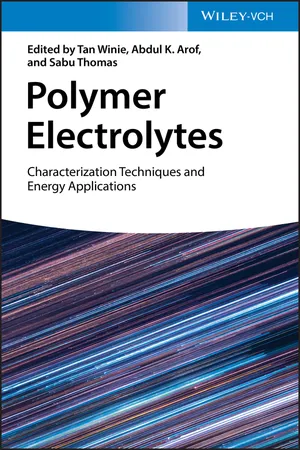
Polymer Electrolytes
Characterization Techniques and Energy Applications
- English
- ePUB (mobile friendly)
- Available on iOS & Android
Polymer Electrolytes
Characterization Techniques and Energy Applications
About This Book
A comprehensive overview of the main characterization techniques of polymer electrolytes and their applications in electrochemical devices Polymer Electrolytes is a comprehensive and up-to-date guide to the characterization and applications of polymer electrolytes. The authors? noted experts on the topic? discuss the various characterization methods, including impedance spectroscopy and thermal characterization. The authors also provide information on the myriad applications of polymer electrolytes in electrochemical devices, lithium ion batteries, supercapacitors, solar cells and electrochromic windows. Over the past three decades, researchers have been developing new polymer electrolytes and assessed their application potential in electrochemical and electrical power generation, storage, and conversion systems. As a result, many new polymer electrolytes have been found, characterized, and applied in electrochemical and electrical devices. This important book: -Reviews polymer electrolytes, a key component in electrochemical power sources, and thus benefits scientists in both academia and industry
-Provides an interdisciplinary resource spanning electrochemistry, physical chemistry, and energy applications
-Contains detailed and comprehensive information on characterization and applications of polymer electrolytes Written for materials scientists, physical chemists, solid state chemists, electrochemists, and chemists in industry professions, Polymer Electrolytes is an essential resource that explores the key characterization techniques of polymer electrolytes and reveals how they are applied in electrochemical devices.
Frequently asked questions
1
Polymer Electrolytes: State of the Art
1.1 Introduction
Table of contents
- Cover
- Table of Contents
- Preface
- 1 Polymer Electrolytes: State of the Art
- 2 Impedance Spectroscopy in Polymer Electrolyte Characterization
- 3 Thermal Characterization of Polymer Electrolytes
- 4 Energy in a Portable World
- 5 Insight on Polymer Electrolytes for Electrochemical Devices Applications
- 6 Polymer Electrolyte Application in Electrochemical Devices
- 7 Polymer Electrolytes for Lithium Ion Batteries and Challenges: Part I
- 8 Polymer Electrolytes for Lithium Ion Batteries and Challenges: Part II
- 9 Polymer Electrolytes for Supercapacitor and Challenges
- 10 Polymer Electrolytes for Quantum Dot‐Sensitized Solar Cells (QDSSCs) and Challenges
- 11 Polymer Electrolytes for Perovskite Solar Cell and Challenges
- 12 Polymer Electrolytes for Electrochromic Windows
- Index
- End User License Agreement